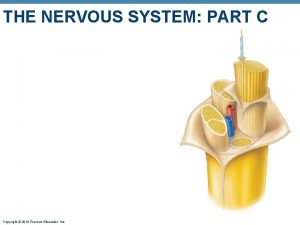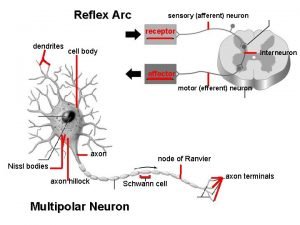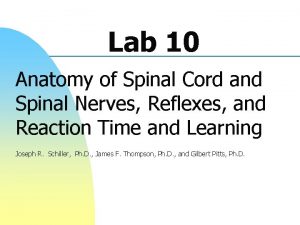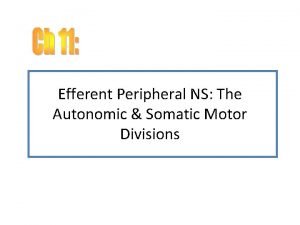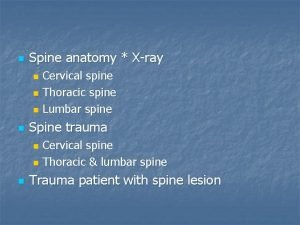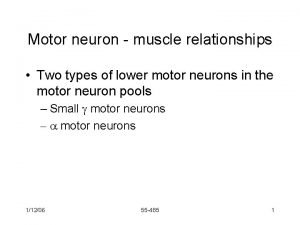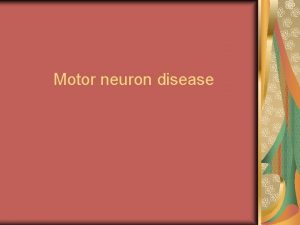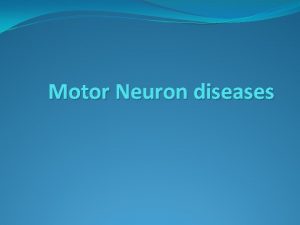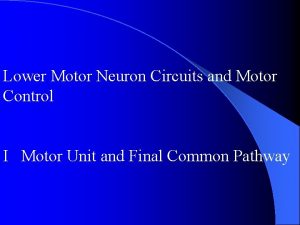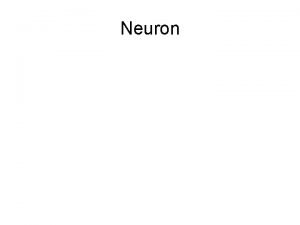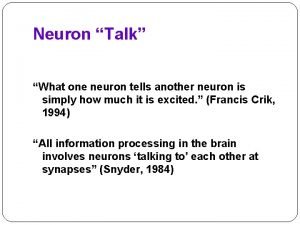Motor neuron muscle relationships Two types of lower














- Slides: 14

Motor neuron - muscle relationships • Two types of lower motor neurons in the motor neuron pools – Small motor neurons – motor neurons 1/12/06 55 -485 1

1/12/06 55 -485 2

Small motor neurons • Innervate sensory structures in skeletal muscle (muscle spindles) • Muscle spindles are embedded in connective tissue – Are called intrafusal muscle fibers 1/12/06 55 -485 3

Small motor neurons • In Intrafusal muscle fibers – Sets the intrafusal muscle fiber to an appropriate length for the sensory neuron to function. 1/12/06 55 -485 4

Effect of motor neurons • Terminate on spindle poles • Stimulate intrafusal contraction • Maintain intrafusal tension • The muscle spindles are able to function. 1/12/06 55 -485 5

motor neurons • Large • Innervate extrafusal muscle fibers. These generate force for movement and posture. 1/12/06 55 -485 6

Motor neurons • Lower motor neurons in the spinal cord • Brainstem motor neurons for head and neck movement in 8 cranial nerves, also called lower motor neurons. 1/12/06 55 -485 7

The motor unit • motor neurons innervate all the extrafusal muscle fibers • Individual motor neurons synapse broadly over a muscle. • An action potential from a motor neuron brings all of the innervated fibers to threshold 1/12/06 55 -485 8

motor neurons • Motor units and motor neurons vary in size. • Small motor neurons innervate fewer muscle fibers than large motor neurons. 1/12/06 55 -485 9

• Different types of motor units produce movements appropriate for different circumstances. 1/12/06 55 -485 10

Small motor neurons • • Small motor units Contract slowly Generate small forces Lots of myoglobin (red) Lots of mitochondria Lots of capillaries (red) Resistant to fatigue Called slow (S) motor units 1/12/06 55 -485 11

Large motor neurons innervate muscle fibers that • • • Are large and pale contract forcefully Have sparse mitochondria Fatigue easily Fast fatigable (FF) motor units 1/12/06 55 -485 12

Fast Fatigue-resistant motor units • • Motor units of intermediate size Not as fast as FF units More resistant to fatigue than FF units Generate more force than slow units 1/12/06 55 -485 13

Threshold for activation • Small slow motor units have low threshold of activation – Are tonically active (posture) 1/12/06 55 -485 14
 Lower motor neuron lesion
Lower motor neuron lesion Lower motor neuron
Lower motor neuron Princip alternatora
Princip alternatora Motor unit consists of
Motor unit consists of Toe dancers muscle a two bellied muscle of the calf
Toe dancers muscle a two bellied muscle of the calf Structure of spinal cord
Structure of spinal cord Site of somatic motor neuron cell bodies
Site of somatic motor neuron cell bodies Umnl vs lmnl
Umnl vs lmnl Somatic motor neuron
Somatic motor neuron Soap note
Soap note Somatic nervous system
Somatic nervous system Somatic motor system
Somatic motor system Somatic motor neuron
Somatic motor neuron Somatic vs autonomic nervous system
Somatic vs autonomic nervous system Chart
Chart





